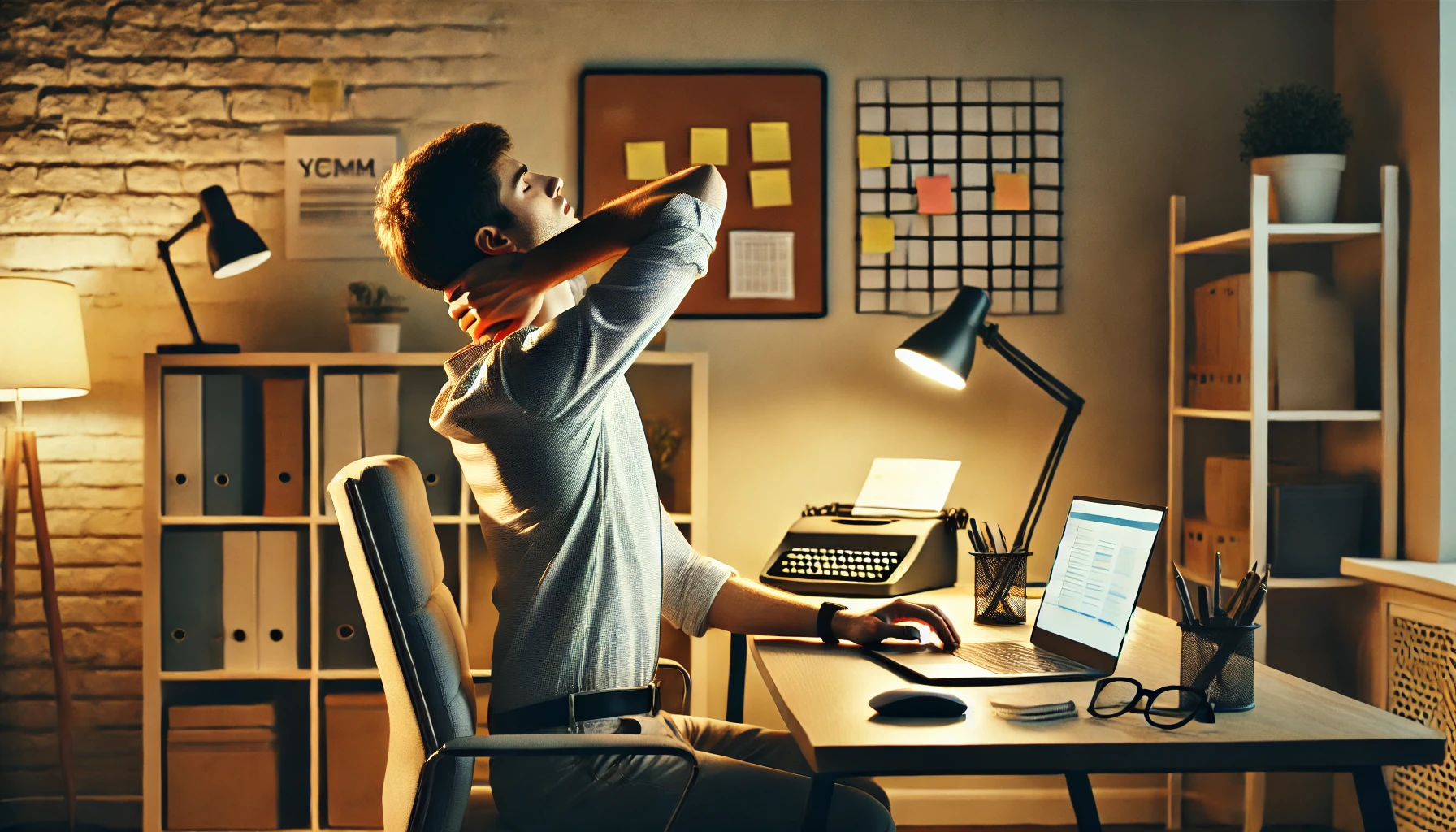FAST FACTS
- People who spend the maturity of their workday sitting have an increased threat of cardiovascular complaint and mortality, experimenters set up.
- Negative effects of sitting Experts say sitting for long ages can contribute to low reverse and neck pain, changes in spinal alignment, and conditions similar to high blood pressure and cholesterol.
- To combat these Negative effects of sitting, experts recommend taking regular breaks, engaging in physical exertion, and perfecting your workspace to reduce strain on your body.
For the large maturity of Americans, going to work means long hours of sitting down at an office. [1] And with colder, darker days incoming, it’s likely that numerous people will spend adding quantities of their free time sitting down, too.
Sitting for long periods of time at an office or in front of a screen can take a risk on a person’s internal and physical health. [2] Plus, a large study published before this time in JAMA Network Open set up that those who were sedentary at work had a 34% increased threat of mortality from cardiovascular complaint and a 16% increased threat of all- cause mortality. [3]
Being sedentary for long ages of time has come increasingly common, especially with further people working from home, said Anel Pla, CPT, certified particular coach at 5 Point Zero Fitness.
“The average office worker sits for about ten hours a day, including lunch, whether they are tracking emails, making calls, or writing reports on a computer.” Pla mentioned Health. “ Also, after work, it’s more like sitting in front of the television or browsing the web. ”
However, if “sitting is the new smoking,” what steps should office workers take to protect their health? [4] Luckily, exploration also shows that adding further movement into your day can help alleviate these issues. In the JAMA Network Open study, actors who alternated between sitting and moving at work did n’t see an increased threat of a docked lifetime. [3]
“These results highlight the need to decrease extended periods of sitting in the plant and increase physical activity during the day,” Wayne Gao, PhD, the study’s first author and an informed Health that she is an associate professor at the Taipei Medical University College of Public Health in Taiwan.
That’s what experts had to say about the health consequences of sitting for long ages and what you can do to avoid these Negative effects of sitting— indeed if you work a 9- to- 5.
What Takes Place in Your Body During Extended Sitting?
Sitting for extended periods of time during the day can have a variety of positive effects on your body.
For one, it has been associated with metabolic patterns, a cluster of conditions including high blood pressure, elevated blood sugar, redundant body fat, and abnormal cholesterol situations, “ all of which up your threat for heart complaint, stroke, and type 2 diabetes, ” Pla explained. [5] [6]
Sitting for long ages of time has also been associated with other habitual conditions, including rotundity and madness threat. [7] [8]
This can be because when the body’s largest muscles are n’t moving, it burns calories less efficiently, Cheng- Han Chen, MD, PhD, cardiologist and medical director of the structural heart Health was informed about the MemorialCare Saddleback Medical Centre program.
However, if your muscles aren’t working, your body isn’t metabolising glucose, which leads to poor blood sugar regulation. It simply becomes unbalanced.
Because people who sit more do n’t move their muscles as much, they’re also at threat for muscle loss and disabled blood inflow, Pla added. This muscle loss, again, puts a person at threat of habitual conditions similar to high blood pressure. [9] [10]
Pain and spinal issues are also a concern, Jeremy Smith, MD, orthopedic chine surgeon at Hoag Orthopedic Institute, told Health. [11]
“ I see cases where people who have sat at an office job for a long time have a significant change in their spinal alignment and habitual pain, ” Smith explained. “ Sitting for hours during the day without a break contributes to habitual reverse and neck pain, spinal misalignment, and degenerative change, ” or issues with the discs in a person’s chine.
Basically, “ our bodies just are n’t erected for sitting all day, ” said Pla. “We are designed to move and stand erect.”
How Can You Reduce the Pitfalls of Dragged Sitting?
Because of the negative health consequences of a sedentary life, it’s stylish for people to avoid sitting for long ages of time each day. Still, work schedules frequently make that a grueling task.
But experts say there are still effects people can do to alleviate the health pitfalls associated with prolonged sitting, Gao said.
Employers should integrate further frequent breaks into their workers’ routines, give access to standing divisions, establish specific workspaces for physical exertion, and give spa class benefits, Gao and his platoon recommended. [3]
“ These changes can help shift the culture and perception of prolonged occupational sitting, ” he said. “ By promoting a terrain that encourages movement and physical exertion, individuals may be more motivated to reduce their sitting time and borrow healthier habits. ”
These systemic changes to plant culture may take time to apply. But for now, experts said each existent can try to make the following changes if they’re sitting too much at work
- Take regular breaks. Set a timekeeper to remind yourself to stand, stretch, or walk, Chen said. Experimenters set up that five- nanosecond walks every 30 twinkles neutralize the negative health goods of sitting. [12]
- Invest in a certain office outfit. Office outfit that allows you to incorporate further movement into your day- to- day life could be salutary. You could try a standing office, said Smith, an ergonomic president, or an office routine, Pla added or a desk treadmill.
- Acclimate your workspace. Be sure to acclimate chairpersons, divisions, and any observers or defenses so that they’re at the correct height to promote good posture and help slouching.
- Engage in regular physical exertion. Make trouble to include regular physical exertion in your routine, similar to walking, running, toning, dancing, biking, and other conditioning. Aim for at least 150 twinkles of moderate- intensity physical exertion per week. [13]
- Stretch and perform certain exercises at your office. Chen mentioned that you can perform various stretches and exercises, such the figure four stretch, shoulder rolls, and neck stretches, while seated or close to your desk.You can also do occasional syllables, standing jabs, or wall drive- ups near your workspace to engage your muscles, he added.
“ Find openings for physical exertion. Look for ways to incorporate physical exertion into your diurnal routine, ” Gao said. Choose the stairs rather than the lift, try to cycle or walk to work or go for a stroll during your lunch hour. These kinds of tiny adjustments can have a big impact.
13 Sources
- Martinez-Amezcua P, Duffy EY, Hiremath PG, et al. openings to ameliorate cardiovascular health in the new American plant. Am J Prev Cardiol. 2020; 5100136. doi 10.1016/ j.ajpc.2020.100136
- Devi KA, Singh SK. The hazards of inordinate screen time Impacts on physical health, internal health, and overall well- being. J Educ Health Promot. 2023; 12413. doi 10.4103/ jehp.jehp_447_23
- Gao W, Sanna M, Tsai MK, Chen YH, and Wen CP. Occupational sitting time, rest physical exertion, and all- cause and cardiovascular complaint mortality. JAMA Network Open. 2024; 7( 1) e2350680. doi 10.1001/ jamanetworkopen.2023.50680
- State of Victoria Better Health Channel. The troubles of sitting is why sitting is the new smoking.
- Macías N, Espinosa- Montero J, Monterrubio- Flores E, et al. Screen- grounded sedentary actions and their association with metabolic pattern factors among grown-ups in Mexico. Prev Chronic Dis 2021; 18210041. doi 10.5888/ pcd 18.210041
- Cieśla E, Kozieł D, Rębak D, Suliga E, and Głuszek S.Relationship between sitting time, physical exertion, and metabolic pattern among grown-ups depending on body mass indicator( BMI). Med Sci Monit. 2018; 247633- 7645. doi 10.12659/ MSM.907582
- Raichlen DA, Aslan DH, Sayre MK, et al. Sedentary geste and incident madness among aged grown-ups. JAMA. 2023; 330(10)934-940. doi 10.1001/ jama.2023.15231
- Pedrero- Chamizo R, Olivares PR, Gómez- Cabello A, et al. In older Spanish persons, sitting time increases the risk of obesity and rotundity independently of walking time. Salutations. 2012; 73( 4) 337- 343. doi 10.1016/ j.maturitas.2012.09.001
- Hwang CL, Chen SH, Chou CH, et al. The physiological benefits of sitting lower and moving more openings for unborn exploration. Prog Cardiovasc Dis. 2022; 7361- 66. doi 10.1016/ j.pcad.2020.12.010
- Bu SY. Association of cadaverous muscle mass and threat of hypertension in Korean grown-ups secondary analysis of data from the community- grounded prospective cohort study. Front Nutr. 2023; 101254109. doi 10.3389/ fnut.2023.1254109
- UCLA Health. Ergonomics for prolonged sitting.
- Duran AT, Cheung YK, Diaz KM, Ensari I, Friel CP, Serafini MA, and Ensari I. Breaking up prolonged sitting to improve cardiometabolic risk: dose-response analysis of a randomized crossover trial. Med Sci Sports Exerc. 2023;55(5):847-855. doi:10.1249/MSS.0000000000003109
- Centers for Disease Control and Prevention. Adult activity: an overview.

